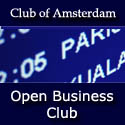Welcome
to our bi-weekly ![]() Club
of Amsterdam Journal.
Club
of Amsterdam Journal.
Join our LABs in Spain!
In the LABs deep analysis is constructed in a collaborative process
of dialogue and future scenario design. The LABs result in analysis
and strategic recommendations for do plans. Our first LAB is about old
an new energy together with internationally reknown specialists withe
expertise in sustainable energy, environmental issues,
nuclear energy and nanotechnology related solutions. ![]() LAB
on Old and New ENERGY
and
LAB
on Old and New ENERGY
and ![]() Q&A
with Paul Holister about Nanotechnology & Energy
Q&A
with Paul Holister about Nanotechnology & Energy
We
also provide resources about energy in the sections with
![]() articles,
articles,
![]() books,
books,
![]() links
and the
links
and the ![]() Summit
for the Future Report 2005
Summit
for the Future Report 2005
Join our discussion about ![]() the
future of the Global Workplace on March 29.
the
future of the Global Workplace on March 29.
Felix Bopp, editor-in-chief
| .Innovation - a hybrid connection between old practices? | ||
 |
Q&A with Humberto Schwab, Director Club of Amsterdam, Innovation Philosopher, Moderator of the Club of Amsterdam LABs in Girona, Spain |
|
|
|
||
| .Energy LAB | ||
|
||
| .News about the future of Energy | ||
 |
The good news first. Renewable energy, combined with the smart use of energy, can deliver half of the world's energy needs by 2050.This new report, 'Energy [R]evolution: A sustainable World Energy Outlook', shows that it is economically feasible to cut global CO2 emissions by almost 50% within the next 43 years. It also concludes that a massive uptake of renewable energy sources is technically possible. All that is missing is the right policy support. The bad news is that time is running out. An overwhelming consensus of scientific opinion now agrees that climate change is happening, is caused in large part by human activities (such as burning fossil fuels), and if left un-checked, will have disastrous consequences. Furthermore, there is solid scientific evidence that we should act now. |
|
 |
Sealing
carbon dioxide (CO2) under the seabed in Japan Injecting carbon dioxide into the ground is a technology currently used for the subterranean storage of natural gas and for increasing petroleum production - known as "enhanced oil recovery," or EOR. The idea behind sub-seabed storage is to apply this technology in the interests of environmental conservation. It is estimated that up to 90 billion tons of carbon dioxide can be stored in subterranean locations in Japan and sub-seabed locations in Japanese waters. This corresponds to 70 to 80 years' worth of Japanese carbon dioxide emissions. As Japan has a wealth of experience and know-how in underground storage of natural gas and EOR technology, its work in the field of carbon dioxide sequestration is thought to be closest to practical application. Murai Shigeo, the leader of the RITE carbon dioxide sequestration group: "We have been able to show that carbon dioxide injection in Japan's particular geological conditions is possible, and computer simulations based on our monitoring activity give a good idea of how the gas will behave over the next thousand years." |
|
| .Club of Amsterdam blog | ||
 |
February
12: |
|
| .News about the Future | ||
 |
|
|
 |
Realeyes3D was selected from 20 MobileMonday Global Peer Award finalists chosen from all over the world as best-of-breed companies demonstrating exceptional innovativeness in mobility. Realeyes3D operates at two levels: It runs a mobile copy service for camera phone users, www.qipit.com and sells “handwritten messaging” applications to handset vendors. |
|
| .Q&A with Paul Holister about Nanotechnology & Energy | ||
 |
Paul Holister is a consultant specialising in, among other things, the commercial and societal impacts of new technologies. He is currently writing "Nanotechnology and the Future of Energy", to be published by John Wiley and Sons. Paul is a Thought Leader at the |
|
Club of Amsterdam: Paul, you are currently writing a book about "Nanotechnology and the Future of Energy". Can you describe how nanotechnology can have an impact on energy generation, storage, and utilization? Nanotechnology operates at such a fundamental level that there is very little of a technological nature that it will not impact. Thus its effects on energy generation, transmission, storage and consumption are numerous and diverse. Some will be incremental and some quite possibly revolutionary. Rather than trying to sketch the whole landscape, a few examples will hopefully illustrate the variety. At the mundane end of the scale you have anti-fouling paints for wave or tidal power, or materials with a higher tolerance for radiation in nuclear reactors. I did say mundane. In wind power, the potentially enormous improvements in strength-to-weight ratio of composite materials used in blades could pay back surprisingly well because the relationship of blade length to efficiency is not linear but follows a power law - though there is much argument about how this pans out in the real world. At the other extreme of nanotech impact, you have solar energy. We are children in this area, and the playground is built on the nanoscale. Almost any development is going to involve nanotech - an intriguing recent exception being the use of lenses to focus light on old-fashioned silicon photovoltaics, thus demanding less of this expensive material. This is one of the areas where nanotech-enabled technology could well be revolutionary. But what makes for a revolution in energy generation? Two things: availability and economics. The fact that solar energy is so bountiful - enough hits the Earth in a minute to meet our global requirements for at least a week - makes it potentially revolutionary; it's just the cost of capturing that energy that has been standing in the way. Reduce that enough, or increase the cost of the alternatives, and you have a revolution. One other energy source could, I believe, be equally revolutionary. Not fusion, which, despite the dreams of my youth, I sadly have to relegate to a distant future - not that the ongoing experiments aren't worthwhile. Geothermal energy, boring as hot rocks and steam may sound - outside of saunas, that is -, has revolutionary potential for the same reason as solar - an essentially unlimited supply of energy untapped only because of economics. The nanotech connection is not as direct here as with solar - you have tougher materials to cut drilling costs or thermoelectric tunneling for efficient low-grade heat conversion - but it only takes the right conjunction of developments and geothermal power stations will be springing up - or down - all over the place. I've only considered here principal power generation, but this should already give some sense of the breadth and potential scale of impact. I'd be surprised to find any reader of this unaware of the excitement surrounding developments in fuel cell and battery technology. Nanotechnology figures almost without exception in the cutting edge of both. But I could go on for
ages answering this question - you could almost make a book out
of it ... On the environmental front the answer is not so clear. We live in a world where short-term economics have an overwhelming influence on decision making. The good news for those who worry about things like global warming, is that the increasing cost of oil - a long-term trend that will not stop, oil being a finite resource - and the decreasing cost of alternatives such as solar energy, give renewables an ever more favourable economic position. When you look at the diverse spread of nanotech-related impacts they are almost always supporting technologies with an improved environmental profile. Unfortunately, there is a rather big exception to this. Nanotechnology has helped greatly improve the effectiveness of catalysts. Fuel cells and catalytic converters are among the welcome beneficiaries. But catalysis is also at the heart of gas-to-liquid and coal liquefaction technologies that promise oil independence for those with access to previously uneconomical gas reserves or to coal reserves. Energy security is a big carrot and it so happens that two highly-populated countries that rank among the fastest-growing economies in the world, and thus the fastest-growing energy consumers, are coal-rich: China and India. North America too is coal-rich. If such countries can start to economically run their cars, trucks and buses on diesel made from coal - which ironically is low-emission compared with normal diesel at the vehicle end but overall produces more CO2 than oil-based diesel - then we could be looking at a greenhouse gas nightmare scenario - there is enough coal in the world to supply our energy needs for hundreds of years. So, greenhouse nightmare
or an emission-free future? Nanotechnology can enable them both.
Barring a global wave of forward planning unseen in mankind's history,
economics will probably make the decision for us. We have gorged ourselves for more than a century on the energy equivalent of a free lunch. As we start to realise that, while there may be such a thing as a free lunch, it isn't necessarily dinner and breakfast too, we can size up the alternatives, the most striking thing about which is their diversity. Only coal and nuclear fission are potential candidates for maintaining the uniform and monolithic energy network we have now in the developed world. There are good reasons to avoid both, if we can - some would argue that we cannot. All the alternatives involve a mix of technologies and energy sources, with energy not always being produced where you want and when you want, thus producing a far more complex system than we have now. The phrase 'intelligent grid' is often held up as an example of how this complexity will operate, with buying, selling and saving of energy being possible at many scales. I'd rather do away with the 'grid' word altogether because it evokes the electricity grid that we in the developed world generally take for granted but which exists only as a consequence of our historical dependence on fossil fuels, and is grossly inefficient. In a mixed-energy-source scenario, the traditional grid would be challenged by localised generation, the form of which would vary according to location - Saudi: sunshine; Greenland: geothermal. The gridless or localised grid scenario begs the question of how large amounts of energy will be transferred from one place to another, which will no doubt continue to be either required or an economically viable activity. The classic answer is hydrogen, but it is unfortunately a lousy way to transport energy, thanks largely to its volatility. In theory, the development of cheap, high-load superconducting cables - perhaps made of carbon nanotubes - might keep the old-fashioned grid alive but it seems to me that an efficient means of converting whatever energy source happens to be available to you into a fuel that is liquid, or close to it, at room temperature - e.g. methanol -, combined with a fuel cell technology to make good use of it, would be a hard system to beat when it comes to storage and transmission. As I write, there are
at least a few scientists around the world trying to figure out
ways to outdo Mother Nature in turning sunlight into a compact,
transportable energy source. All of which happens, of course, on
the nanoscale. |
||
| .Next Season Event | ||

|
Thursday, March 29, 2007 Registration: 18:30-19:00, Conference: 19:00-21:15 Where: PricewaterhouseCoopers, Thomas R. Malthusstraat 5, 1066 JR Amsterdam With Mandar Apte, Business Strategy - Competitive Intelligence Analyst, Shell Global Solutions International B.V. Workplace of the future - scenarios and trends - Views of a global citizen Andrew Kruseman Aretz, Partner, Human Resource Services, PricewaterhouseCoopers Belastingadviseurs N.V. Changing demographics of people flows around the World Jean-Claude Knebeler, Director of Foreign Trade, Ministry of the Economy and Foreign Trade, Luxembourg Does off-shoring hold the key to success, especially for SME's? Moderated by Hedda Pahlson-Moller, Managing Director, Omnisource International, Benelux Client Executive for Evalueserve 



Supporter |
|
| .Recommended Book | ||
 |
by David Bodansky The world faces serious difficulties in obtaining the energy that will be needed in coming decades for a growing population, especially given the problem of climate change caused by fossil fuel use. This book presents a view of nuclear energy as an important carbon-free energy option. It discusses the nuclear fuel cycle, the types of reactors used today and proposed for the future, nuclear waste disposal, reactor accidents and reactor safety, nuclear weapon proliferation, and the cost of electric power. To provide background for these discussions, the book begins with chapters on the history of the development and use of nuclear energy, the health effects of ionizing radiation, and the basic physics principles of reactor operation. The text has been rewritten and substantially expanded for this edition, to reflect changes that have taken place in the eight years since the publication of the first edition and to provide greater coverage of key topics. These include the Yucca Mountain repository plans, designs for next-generation reactors, weapons proliferation and terrorism threats, the potential of alternatives to nuclear energy, and controversies about low-level radiation. |
|
| .Cross-Media Summit for Content Discovery | ||
|
ADVERT |
||
|
The Strategy, Technology
and Business Case for Content Description, Visibility, Search and
Discovery How do content owners increase the visibility and discovery of their content? Do we need more standards? What are the drivers for industry adoption? Can we make the tools easier to use? What are the requirements of end-users in the media industry? THE UNIVERSAL CATALOGUE
- IS THERE THE WILL TO BUILD IT? Bringing together key
cross-industry strategists and technologists from standards, search,
image, music and film, shaping the digital media marketplace. Identifying
areas for further investigation to drive adoption of metadata syndication
ecosystems. Participants will share experiences, discover synergy
and innovate. |
||
| .Media LAB | ||
|
||
| .Agenda | ||
|
||
|
||
|
||
| .Club of Amsterdam Open Business Club | ||

|
Are you interested in networking, sharing visions, ideas about your future, the future of your industry, society, discussing issues, which are relevant for yourself as well as for the 'global' community? The future starts now - join our online platform ...: http://www.openbc.com/go/invuid/Felix_Bopp2 CIWI - Creative Minds Worldwide |
|
| .Contact | ||
|
||
| .Subscribe & Unsubscribe | ||
|
||
| m | ||
Copyright © 2002-2007, Club of Amsterdam. All rights reserved.







 ...
... ...
...




